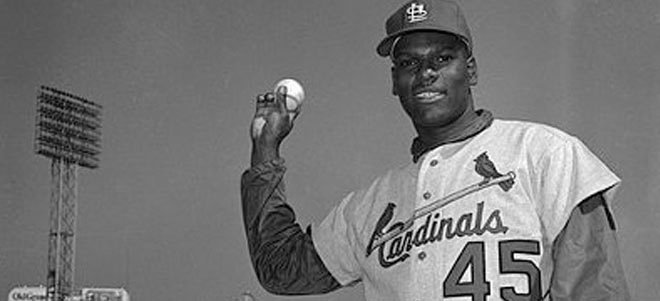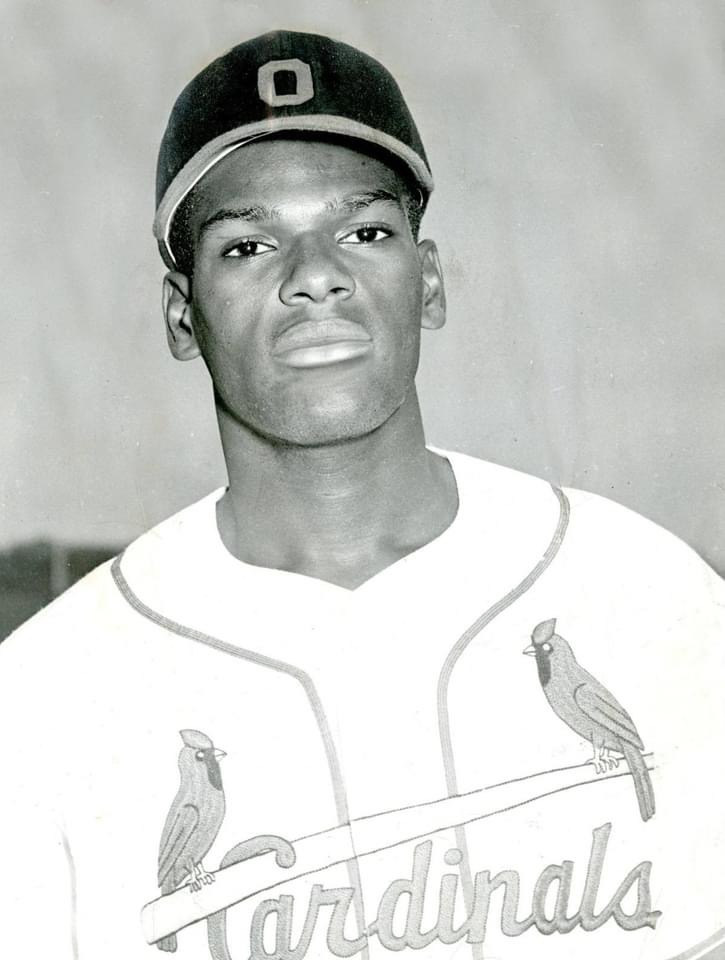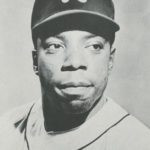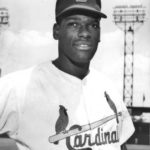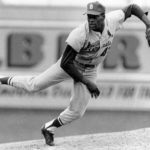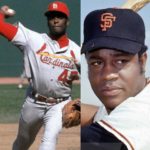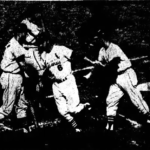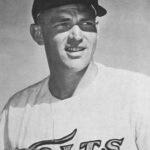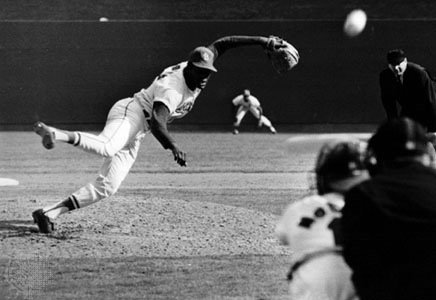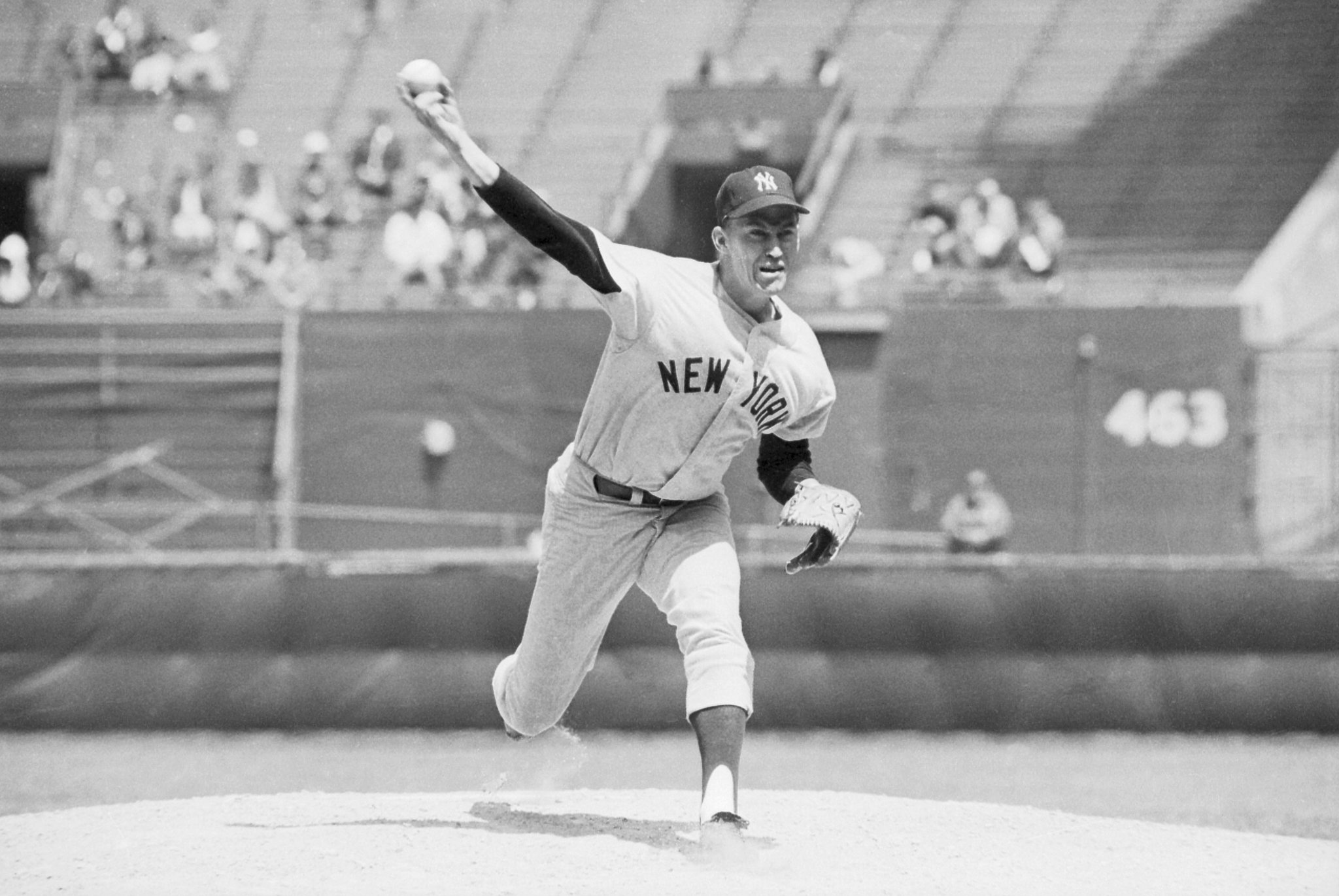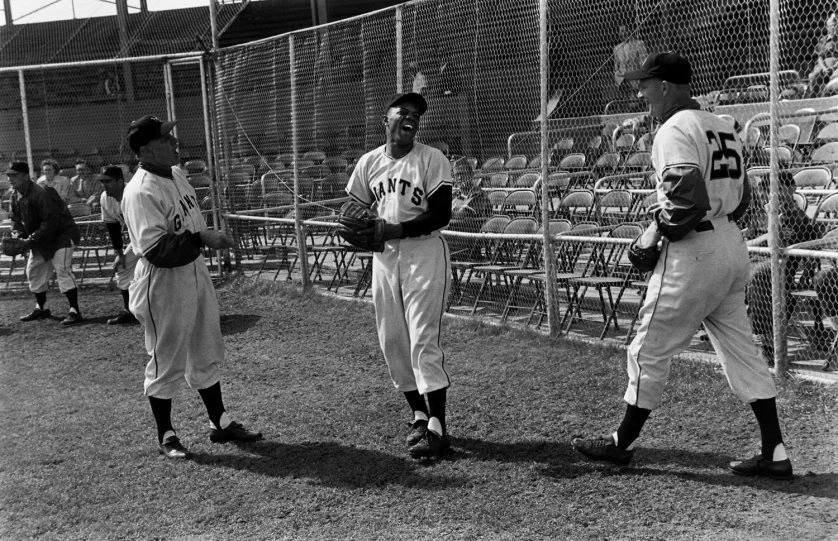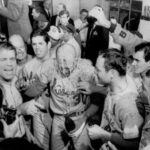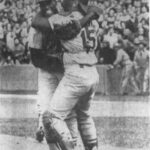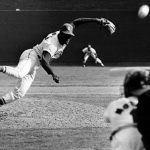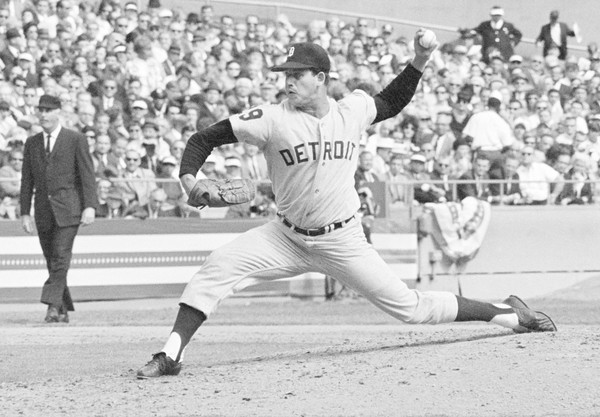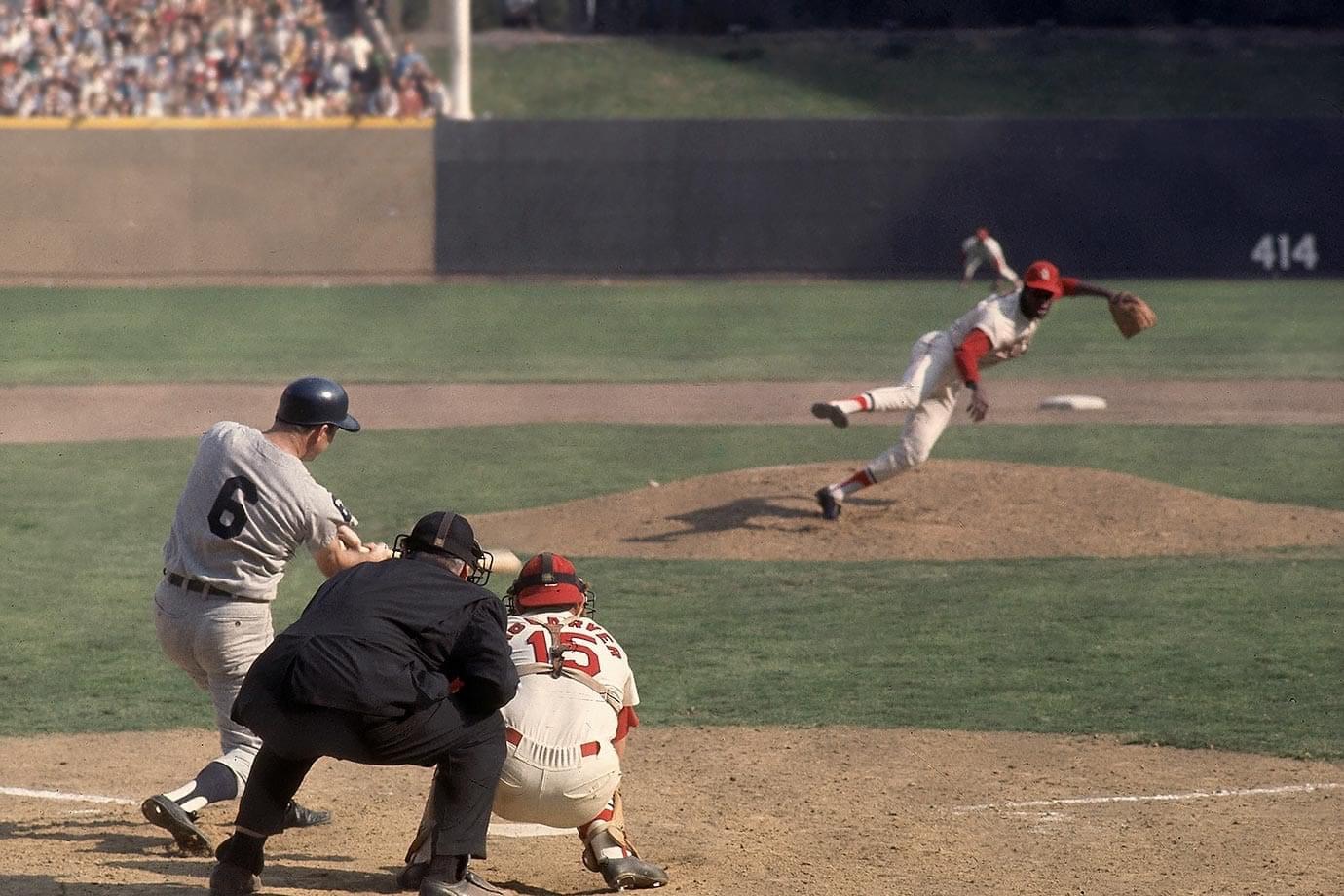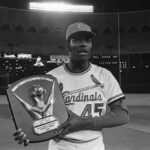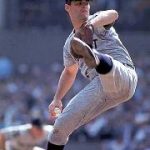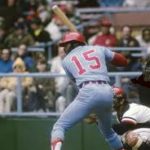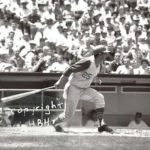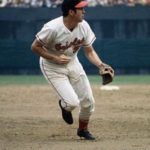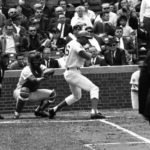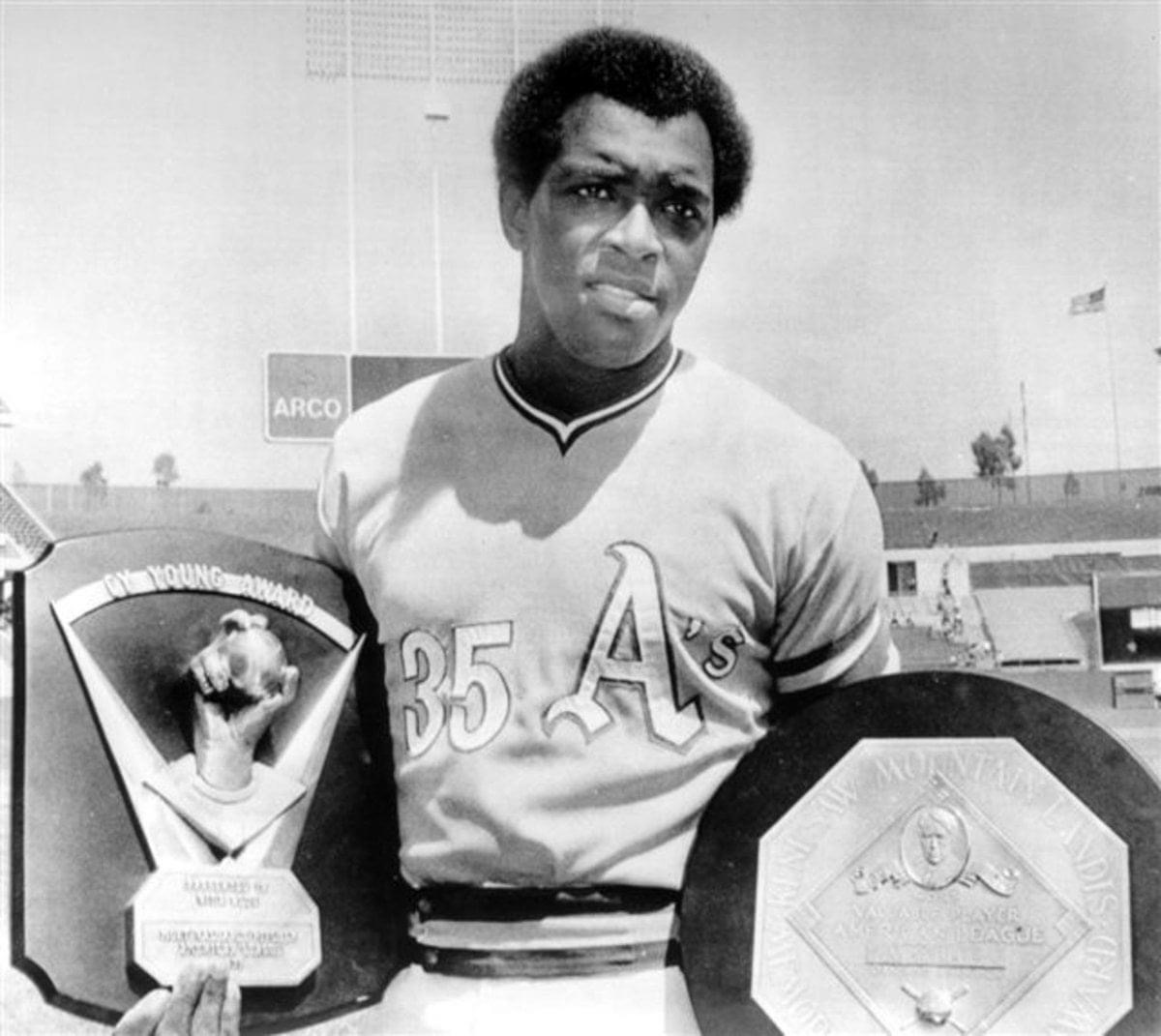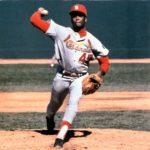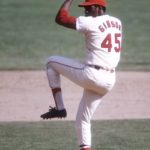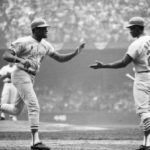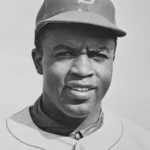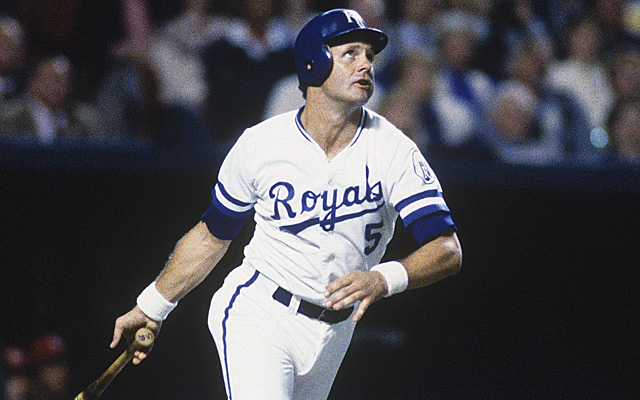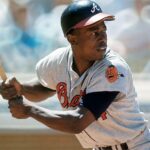Bob Gibson Stats & Facts
Bob Gibson Essentials
Position: Pitcher
Bats: Right • Throws: Right
6-1, 189lb (185cm, 85kg)
Born: November 9, 1935 in Omaha, NE
High School: Tech HS (Omaha, NE)
School: Creighton University (Omaha, NE)
Debut: April 15, 1959
vs. LAD 2.0 IP, 2 H, 0 SO, 0 BB, 2 ER
Last Game: September 3, 1975
vs. CHC 1.0 IP, 2 H, 0 SO, 3 BB, 5 ER, L
Hall of Fame: Inducted as Player in 1981. (Voted by BBWAA on 337/401 ballots)
View Bob Gibson’s Page at the Baseball Hall of Fame (plaque, photos, videos).
Full Name: Robert Gibson
Nicknames: Hoot or Gibby
View Player Bio from the SABR BioProject
Nine Players Who Debuted in 1959
Willie McCovey
Billy Williams
Maury Wills
Tommy Davis
Jim Kaat
Tim McCarver
Jim Perry
Mike Cuellar
Zoilo Versalles
The Bob Gibson Teammate Team
C: Tim McCarver
1B: Stan Musial
2B: Julian Javier
3B: Ken Boyer
SS: Dal Maxvill
LF: Lou Brock
CF: Curt Flood
RF: Roger Maris
SP: Steve Carlton
SP: Jerry Reuss
SP: Curt Simmons
SP: Lew Burdette
RP: Al Hrabosky
M: Red Schoendienst
Baseball is the only game you can watch on the radio. Join the community today and listen to hundreds of broadcasts from baseball’s golden age
Notable Events and Chronology for Bob Gibson Career
The greatest big-game pitcher of his era, and perhaps of all-time, Gibson almost single-handedly won two World Series for the Cardinals in the 1960s, and nearly won another. He was the ultimate warrior on the mound – mean and focused on one thing – winning. In 1968, he enjoyed one of the most dominating seasons in baseball history, posting a 1.12 ERA and winning 22 games. Twice he was named Most Valuable Player of the World Series, and he is the only pitcher to win Game Seven and hit a home run in the same game.
Biography:
Pack Robert Gibson was born on November 9, 1935 in Omaha, Nebraska. Later known as Hoot or Gibby, he changed his official name to Robert when he turned 18 years old. When he was 3 years old, his father passed away, which was just the start to a very tough childhood where he fought through a multitude of illnesses, which included asthma, pneumonia and a heart murmur. His tough upbringing helped him become a man before most were boys. Not only was he mentally tough, but his pure physicality and athleticism helped him excel in baseball and basketball as a youngster. Gibson became a standout athlete in both sports in high school, especially basketball where he received a scholarship to play at Creighton University. Gibson would also go on to play for the Harlem Globetrotters and he would become known for his superior athleticism and reverse dunks. Gibson signed with the Cardinals as a free agent in 1957 and was finally pulled away from the game of basketball when the GM of the Cardinals gave him a $3,000 bonus to focus on baseball. And focus he did. By the end of his Hall of Fame career, he would be remembered as one of the best pitchers ever to toe the rubber.
Starting his professional baseball career in 1958 at Triple-A Omaha, Gibson made his St. Louis Cardinal debut just a year later on April 15, 1959 versus the Los Angeles Dodgers at the age of 23. He pitched 2 innings, allowing 2 hits and 2 earned runs in his debut and finished the season at 3-5 with a 3.33 era striking out 48 batters in 75.2 innings pitched. Even though Gibson’s first three seasons didn’t go as planned as he struggled with his command accruing a 5.1 BB per 9 IP in 1961, he had a breakout year the following year in 1962. Overall, he went 15-13 with a 2.85 era and 208 strikeouts in 30 games in which he started and was selected to his first All Star Game.
The following year, Gibson had a career high 18 wins to go with 9 losses. He started 33 games and averaged 7.2 k/9 which matched his overall career average. In today’s game, complete games are few and far between, but in Gibson’s day, they seemed to happen more times than not. Gibson would compile 14 complete games and pitch 254.2 innings finishing with 204 strikeouts which were the second time in his young career that he eclipsed the 200 strikeout mark.
The next season in 1964, Gibson turned in another stellar year going 19-12 with a 3.01 era, 17 complete games, 245 strikeouts in 36 starts. This is the year that Gibson seemed to establish himself as one of the games prominent starting pitchers. His intimidating mound presence helped him establish the inside part of the plate. By establishing the inside corner, he was able to increase his strikeout totals, not to mention coming in high and tight which he was known to do throughout most of his career. He would go on to help lead the Cardinals to a regular-season mark of 93-69. Gibson went 2-1 in the World Series with a 3.00 era, 2 complete games and 31 strikeouts in 27 innings. The Cardinals were crowned the World Series Champions of 1964 in a 7 game series against the New York Yankees. Gibson would garner his first of two World Series MVP awards after a promising Fall Classic.
Over the next two seasons, Gibson would record two consecutive 20 win seasons. He went 20-12 in 1965 and 21-12 in 1966. He was named to the National League All Star team in 1965 and 1966 as well as winning a Gold Glove award in each season. This would start a streak of 9 consecutive years where Gibson would win a Gold Glove with his last coming in the 1973 season. His above average defense was mainly due to his superior athleticism and agility as the ex-star basketball player parlayed all of his abilities not just to pitching, but to defense as well.
The 1967 season was a very odd year for Gibson. He suffered a broken leg from a line drive off the bat of Roberto Clemente on July 15. Despite breaking his leg and missing time from July to September, the Cardinals would finish with a 101-60 regular-season record. Regardless of missing ample time, Gibson finished with a season record of 13-7 in 24 starts. He would also finish with an era under 3.00 for the third time in his career and be named to the NL All Star team and win his 3rd Gold Glove. Gibson would bounce back from the injury and lead the Cardinals to their second World Series championship in four years versus the Boston Red Sox. He won games 1,4 and 7 ending up with a 3-0 record, which were all complete games, with a 1.00 era allowing only 3 earned runs and 14 hits over 27 innings pitched. Gibson would go on to be named the World Series MVP for the second time in his career. When the 1967 season ended, another championship was being hoisted in the city of St. Louis. But little did the Cardinal fans know that in the next season they were going to witness the best overall performance by a starting pitcher.
The 1968 season ended in a World Series loss for the Cardinals at the hands of the Detroit Tigers. Gibson went 2-1 with a 1.67 era, 35 strikeouts in 3 complete games which totaled 27 innings. Out of those 35 strikeouts, 17 were in the same game which is a record that still stands today. It was surprising that Gibson lost during the 1968 season, much less 9 times, but run support was hard to come by and Gibson would lose 5 games 1-0. His 1968 season would go down as one of the best seasons ever recorded by a starting pitcher winning 22 games with a 1.12 era which still stands as the lowest ERA in the live-ball era. Gibson would prove that he was the pitcher in the “Year of the Pitcher”. He started 34 games that year and completing 28 of those 34 starts. Also, during the regular season he went 47 consecutive innings without letting up a run, which is the 3rd longest streak in baseball history. Also at one point of the season, he let up only 2 earned runs in 92 innings pitched. He would pitch 304.2 innings that year striking out 268 and only allowing 198 hits and 38 earned runs. His strikeout rate per 9 innings was 7.9 and his strikeout to walk ratio was an unbelievable 4.32 k/bb. Out of these stats, second most impressive stat is that he pitched 13 shutouts. This was nothing new to Gibson as he led the National League in shutouts four times.
His pure dominance in the 1968 season led to a lot of scribbling down of statistical information in the record books as we have never seen a season like that since. Not only were his stats intimidating, but so was his demeanor on the mound. With his fastball sizzling by you and slider diving off the table, Major League Baseball decided that they needed to make a major change so that the pitcher will never have that big of an advantage again. Major League Baseball decided that in 1969 they were going to lower the mound 5 inches from 15 inches to 10 inches due to Gibson’s 1968 season. Because of this, his ERA record of 1.12 in a single season might never be broken again.
The 1970 season seemed to be his last great statistical season going 23-7, which is a personal best for Gibson in his 17 year career. He finished the ’70 season with a 3.12 earned run average in 34 starts. He completed 23 of those starts tossing 294 innings and striking out 274. He struck out 8.4 batters per nine innings which was a career high and led to his 2nd Cy Young Award. He was also named to the All Star team and won his 6th Gold Glove during that season.
Over the last five years of his career spanning from 1971-1975, Gibson was still able to pitch effectively, but not to the level that everybody was used to. He would go a combined 61-57 during that time frame and would collect three more Gold Gloves. He would finish 5th in the Cy Young Award in 1971, but that was the last time we saw Gibson finish that high. And it was during that season he threw his first and only no-hitter of his career on August 14, 1971. The 1975 season proved to be his last at 39 years old. He would pitch 109 innings and record a 3-10 season. His last game would come on September 3, 1975 versus their rival the Chicago Cubs.
To say that Gibson’s career was complete is an understatement. He exceeded at every level that he pitched and seemed to get better throughout his major league career until he was 36 years old. His hunger to compete and intimidation on the mound helped Gibson become one of the most feared pitchers not only during his playing days, but in baseball history. Gibson finished with a career record of 251-174 with a 2.91 era and 3,1117 strikeouts. He was an eight time all star, two time World Series Champion, nine time Gold Glove Award winner, one time National League MVP and two time Cy Young award winner. He was voted into the Hall of Fame in 1981 with 84% of the vote.
Unform Number
#58 (1959), #31 (1960), #45 (1961-1975)
Quotes From
“A great play is like watching a girl go by. The last one you saw is the prettiest.”
Replaced By
John Denny, in 1975-1976, whom the Cards were grooming as their ace of the future.
Best Season: 1968
He went 22-9 and completed 28 of his 34 starts. He led the NL with 268 strikeouts and 13 shutouts. Five of his shutouts came consecutively, and at one point he pitched 47 1/3 straight scoreless innings. Amazingly, the right-hander allowed just 38 earned runs all season, in more than 300 innings. His ERA of 1.12 was the third best in league history. Opponents batted .184 and had just a .233 OBP. He lost nine games, but in three of those he allowed just a single run. He won both the Cy Young and the MVP award.
Factoid 1
On July 17, 1974, Bob Gibson fanned Cesar Geronimo for the 3000th K of his career
Factoid 2
After scoring 15 points for Creighton University against the Harlem Globetrotters in 1957, Bob Gibson was signed by the Globetrotters and played with the famous barnstorming basketball team for one season.
Transition
Signed as an amateur free agent by St. Louis Cardinals (1957).
Strengths
Competitiveness Don’t mess with ‘Hoot’ Gibson was known for pitching inside to batters. Dusty Baker received the following advice from Hank Aaron about facing Gibson: “‘Don’t dig in against Bob Gibson, he’ll knock you down. He’d knock down his own grandmother if she dared to challenge him. Don’t stare at him, don’t smile at him, don’t talk to him. He doesn’t like it. If you happen to hit a home run, don’t run too slow, don’t run too fast. If you happen to want to celebrate, get in the tunnel first. And if he hits you, don’t charge the mound, because he’s a Golden Gloves.’ I’m like, ‘Damn, what about my 17-game hitting streak?’ That was the night it ended.” Dick Allen stated that, “Bob Gibson was so mean he would knock you down and then meet you at home plate to see if you wanted to make something of it.” Gibson showed no mercy, even to players he liked. Gibson’s closest friend on the Cardinals was first baseman Bill White (first baseman), who was later traded to the Philadelphia Phillies. The first time White batted against Gibson as a Phillie, Gibson hit him on the arm with a fastball (there were no hard feelings, and the friends had dinner together that night).
Gibson was surly and brusque even with his teammates. When his catcher Tim McCarver went to the mound for a conference, Gibson brushed him off, saying “The only thing you know about pitching is you can’t hit it.” Gibson maintained this image even into retirement.
In 1992, an Old-Timers’ Day was played at Jack Murphy Stadium in San Diego as part of the All-Star Game festivities, and Reggie Jackson hit a home run off Gibson. When the Old-Timers’ Day game was played in 1993, the 57-year-old Gibson threw the 47-year-old Jackson a brushback pitch. The pitch was not especially fast and did not hit Jackson, but the message was delivered, and Jackson did not get a hit.
Once, while providing commentary for a Cardinal baseball game on radio station KMOX, Gibson was queried by fellow announcer and former Cardinal, Mike Shannon, as to how Gibson might have faced home run king Babe Ruth. Shannon referred to Babe Ruth’s Called Shot (an indication that Ruth would hit the ball into the bleachers), to which Gibson responded, “If a batter ever pointed to the bleachers in front of me, he’d have some sore ribs.”.
Gibson casually disregards his reputation for intimidation, though, saying that he made no concerted effort to seem intimidating. He recently joked that the only reason he made faces while pitching was that he needed glasses and could not see the catcher’s signals which is given credence since Cardinal’s catchers went to tapping for signals instead of the more usual hand signs.
Weaknesses
Early in his career he was a little wild, but not for long.
Milestones
Honors His number 45 is retired by the St. Louis Cardinals, and in 1981, he was inducted into the Baseball Hall Of Fame. In 1999, he ranked Number 31 on The Sporting News’ list of the 100 Greatest Baseball Players, and was elected to the Major League Baseball All-Century Team. He has a star on the St. Louis Walk of Fame. A bronze statue of Gibson by Harry Weber is located in front of Busch Stadium, commemorating Gibson along with other St. Louis Cardinals greats. In 2004, he was named as the most intimidating pitcher of all time from the Fox Sports Net series The Sports List. The street on the north side of Rosenblatt Stadium, home of the College World Series in his hometown of Omaha, is named Bob Gibson Boulevard.
The 12 Black Aces
Through 2004, twelve African-American pitchers had won 20-games in the major leagues. Of course, black pitchers had won twenty many times in the negro leagues, but these dozen, who, under the direction of Mudcat Grant, called themselves the “12 Black Aces,” are an exclusive club:
1. Don Newcombe
2. Sam Jones
3. Bob Gibson.
4. Mudcat Grant
5. Earl Wilson
6. Fergie Jenkins
7. Al Downing
8. Vida Blue
9. J.R. Richard
10. Mike Norris
11. Dwight Gooden
12. Dave Stewart
Hitter and Pitcher
In 1970, Gibson hit .303 with two homers and 19 RBI. He was used as a pinch-hitter five times, drawing two walks and laying down one sacrifice hit. He had at least one hit in 12 of his starts and at least on RBI in 13 of them.
World Series Aces
Pitchers who have hurled three complete game wins in one World Series:
Christy Mathewson, Giants (1905 vs. A’s) 27 IP, 14 H, 18 K, 1 BB, 0.00 ERA
Babe Adams, Pirates (1909 vs. Tigers) 27 IP, 18 H, 11 K, 6 BB, 1.33 ERA
Stan Coveleski, Indians (1920 vs. Robins) 27 IP, 15 H, 8 K, 2 BB, 0.67 ERA
Lew Burdette, Braves (1957 vs. Braves) 27 IP, 21 H, 13 K, 4 BB, 0.67 ERA
Bob Gibson, Cardinals (1967 vs. Red Sox) 27 IP, 14 H, 26 K, 5 BB, 1.00 ERA
Mickey Lolich, Tigers (1968 vs. Cardinals) 27 IP, 20 H, 21 K, 6 BB, 1.67 ERA
@ET-DC@eyJkeW5hbWljIjp0cnVlLCJjb250ZW50IjoicG9zdF90YWdzIiwic2V0dGluZ3MiOnsiYmVmb3JlIjoiTGVhcm4gTW9yZSBhYm91dCB0aGUgdGVhbXMsIHBsYXllcnMsIGJhbGwgcGFya3MgYW5kIGV2ZW50cyB0aGF0IGhhcHBlbmVkIG9uIHRoaXMgZGF0ZSBpbiBoaXN0b3J5IC0gLSAtIC0gLSAtIC0gIiwiYWZ0ZXIiOiIiLCJsaW5rX3RvX3Rlcm1fcGFnZSI6Im9uIiwic2VwYXJhdG9yIjoiIHwgIiwiY2F0ZWdvcnlfdHlwZSI6InBvc3RfdGFnIn19@
Baseball is the only game you can watch on the radio. Join the community today and listen to hundreds of broadcasts from baseball’s golden age
Factoids, Quotes, Milestones and Odd Facts
Quotes From Bob Gibson
“A great play is like watching a girl go by. The last one you saw is the prettiest.”
Teams Bob Gibson Played For
St. Louis Cardinals (1959-1975)
Best Season: 1968
He went 22-9 and completed 28 of his 34 starts. He led the NL with 268 strikeouts and 13 shutouts. Five of his shutouts came consecutively, and at one point he pitched 47 1/3 straight scoreless innings. Amazingly, the right-hander allowed just 38 earned runs all season, in more than 300 innings. His ERA of 1.12 was the third best in league history. Opponents batted .184 and had just a .233 OBP. He lost nine games, but in three of those he allowed just a single run. He won both the Cy Young and the MVP award.
Factoids
On July 17, 1974, Bob Gibson fanned Cesar Geronimo for the 3000th K of his career
After scoring 15 points for Creighton University against the Harlem Globetrotters in 1957, Bob Gibson was signed by the Globetrotters and played with the famous barnstorming basketball team for one season.
The 12 Black Aces
Through 2004, twelve African-American pitchers had won 20-games in the major leagues. Of course, black pitchers had won twenty many times in the negro leagues, but these dozen, who, under the direction of Mudcat Grant, called themselves the “12 Black Aces,” are an exclusive club:
1. Don Newcombe
2. Sam Jones
3. Bob Gibson.
4. Mudcat Grant
5. Earl Wilson
6. Fergie Jenkins
7. Al Downing
8. Vida Blue
9. J.R. Richard
10. Mike Norris
11. Dwight Gooden
12. Dave Stewart
Hitter and Pitcher
In 1970, Gibson hit .303 with two homers and 19 RBI. He was used as a pinch-hitter five times, drawing two walks and laying down one sacrifice hit. He had at least one hit in 12 of his starts and at least on RBI in 13 of them.
World Series Aces
Pitchers who have hurled three complete game wins in one World Series:
Christy Mathewson, Giants (1905 vs. A’s)
27 IP, 14 H, 18 K, 1 BB, 0.00 ERA
Babe Adams, Pirates (1909 vs. Tigers)
27 IP, 18 H, 11 K, 6 BB, 1.33 ERA
Stan Coveleski, Indians (1920 vs. Robins)
27 IP, 15 H, 8 K, 2 BB, 0.67 ERA
Lew Burdette, Braves (1957 vs. Braves)
27 IP, 21 H, 13 K, 4 BB, 0.67 ERA
Bob Gibson, Cardinals (1967 vs. Red Sox)
27 IP, 14 H, 26 K, 5 BB, 1.00 ERA
Mickey Lolich, Tigers (1968 vs. Cardinals)
27 IP, 20 H, 21 K, 6 BB, 1.67 ERA
Where He Played
Starting pitcher
No-Hitter
8/14/1971: For STL (N) vs. PIT (N), 11-0 at PIT. 9 innings pitched.
Post-Season Appearances
1964 World Series
1967 World Series
1968 World Series
Post-Season Notes
Gibson had as much of an impact on his team in ultimate games as any pitcher in baseball history. He started three Game Sevens, winning two.
Awards and Honors
1964 ML WS MVP
1965 NL Gold Glove
1966 NL Gold Glove
1967 NL Gold Glove
1967 ML WS MVP
1968 NL Cy Young
1968 NL Gold Glove
1968 NL MVP
1969 NL Gold Glove
1970 NL Cy Young
1970 NL Gold Glove
1971 NL Gold Glove
1972 NL Gold Glove
1973 NL Gold Glove
Milestones
-
- August 4, 1971: 200th Win…
-
- July 17, 1974: 3000th strikeout… Cesar Geronimo
Pitching Feats
-
- , 1968: …
Transactions
Signed as an amateur free agent by St. Louis Cardinals (1957).
All-Star Selections
1962 NL
1965 NL
1966 NL
1967 NL
1968 NL
1969 NL
1970 NL
1972 NL
Replaced
Gibson stepped into a large void in the Cardinals rotation in 1960-1961.
Replaced By
John Denny, in 1975-1976, whom the Cards were grooming as their ace of the future.
Best Strength as a Player
Competitiveness
Largest Weakness as a Player
Early in his career he was a little wild, but not for long.
Other Resources & Links
Coming Soon
If you would like to add a link or add information for player pages, please contact us here.

